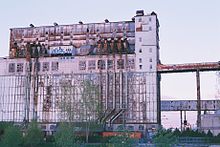- Port of Montreal
-
Port of Montreal 
General information Founded Montreal Port Authority 1999
Montreal Port Company 1983
National Harbours Board 1936
Harbour Commission 1830Area
- Land (Montreal)
- Land (Contrecoeur)6.35 km2 (2.45 sq mi)
4.67 km2 (1.80 sq mi)Major marine terminals 4 Vessel arrivals 2,039 (FY 2010) Annual container volume 1,331,351 Twenty-foot equivalent units (TEU) (FY 2010) Annual cargo tonnage 25,919,667 t (28,571,542 short tons; 25,510,305 long tons) revenue tons (FY 2010) Cruise traffic 40,142 passengers (FY 2010) Jobs 18,280 (total) (FY 2008) Board of Directors Chairman
Vice chairmanMichel M. Lessard
Yves FilionOther board members Marc Y. Bruneau
Jean Depelteau
Normand Morin
Diane Provost
Anik TrudelPresident and CEO Sylvie Vachon Official Website The Port of Montreal, is a port located in Montreal, Quebec, Canada, on the St Lawrence river. It one of the largest inland ports in the world[1], it is the second busiest port in Canada (after Vancouver), and it is one of the busiest ports in North America. It is also the entry point to other major cities such as Toronto, Detroit and Cleveland. It handles 26,000,000 tonnes (28,660,094 short tons; 25,589,370 long tons) of cargo annually.[2] It remains a trans-shipment point for grain, sugar, petroleum products, machinery, and consumer goods. For this reason, Montreal is also the railway hub of Canada.
In 1964, the Canadian Coast Guard began to use icebreakers to keep the navigation channel open, first and foremost as an environmental measure designed to protect riverside communities from spring floods caused by ice jams, but also allowing winter navigation in the port.
The port is preparing to build and operate a new $500-million (U.S.) container facility, and has opened an office in Chicago to promote its advantages in serving the U.S. Midwest.[3]
Contents
Timeline
Starting from the first authority:[4]
- 1830: The first Harbour Commission is created and builds the first permanent wharves and pushes the government to dredge the river.
- 1830-1832: 1,142 metres (3,747 ft) of permanent wharves, retaining walls and ramps are constructed.
- 1840: The first Gold-Headed crane.
- 1851: The first major port and river dredging project begins.
- 1854: The navigation channel between Quebec City and Montreal is deepened.
- 1872: Archives for May 28 note that "there were 70 vessels - 21 of them ocean-going steamships - docked at different berths, representing a total of 53,769 tonnes (59,270 short tons; 52,920 long tons)."
- 1883: Channel is dredged to a minimum of 7.5 metres (25 ft).
- 1902: Start of construction on the modern grain elevators in the port.
- 1908: First permanent transit sheds constructed.
- 1910: Dredging work on the channel to a depth of 10.7 metres (35 ft) begins.
- 1936: The National Harbours Board is created by the federal government.
- 1947: For seven and a half months in the year, more than 25 major steamship lines serve the port.
- 1962: The use of icebreakers to keep the channel between Montreal and Quebec City open during winter is designated by the federal government.
- 1967: The first container is handled.
- 1968: The first Canadian container terminal is inaugurated in Montreal.
- 1972: Construction begins on the Cast container terminal.
- 1977: The millionth TEU container is handled by the port.
- 1978: The Port of Montreal builds the Racine container terminal, expanding its operations in Montreal's east-end.
- 1983: The Montreal Port Corporation is established.
- 1987: The Maisonnneuve (Termont) Container Terminal is opened.
- 1992: Minimum channel depth is enlarged to 11 metres (36 ft).
- 1996: Montreal christens three brand-new vessels, capable of holding 2,300 TEU containers each.
- 1998: Marine Carriers delivery of the three ships capable of transporting 2,800 TEU containers or the equivalent.
- 1999: Under the Canada Marine Act, the Montreal Port Corporation is transformed into the more autonomous Montreal Port Authority.
- 2000: The Port of Montreal handles more than 1 million TEU containers a year for the first time in its history.
See also
- Board of Trade of Metropolitan Montreal
- Economy of Montreal
References
- ^ "Gateway to North America". Port of Montreal. http://www.port-montreal.com/site/1_0/1_1.jsp?lang=en. Retrieved 2011-11-21.
- ^ "The Port of Montreal unveils its project, which will generate $3.4 billion in annual economic spinoffs for Montreal" (PDF). Press Release. Port of Montreal. April 17, 2008. http://www.port-montreal.com/news/en_77_2.pdf. Retrieved 2008-08-01.
- ^ Moore, Lynne (2009-01-06). "After record-breaking year, Port of Montreal seeks growth". Montreal Gazette (Canwest). http://www.montrealgazette.com/story_print.html?id=1145282. Retrieved 2009-01-10.[dead link]
- ^ "Great moments in the history of a major world port" (PDF). Port of Montreal. http://www.port-montreal.com/pdf/Historique_en.pdf. Retrieved 2011-02-11.
External links
Montreal Features 
History Expo 67 · Hochelaga · Mayors · Montreal Urban Community · October Crisis · Oldest buildings and structures · Reorganization of Montreal · 1976 Summer Olympics · Timeline · National Historic Sites of CanadaGeography Economy Politics Public Services Education Commission scolaire de Montréal · Commission scolaire Marguerite-Bourgeoys · Concordia University · English Montreal School Board · Jewish Public Library · Lester B. Pearson School Board · List of schools and libraries · McGill University · Montreal Public Libraries Network · Université de Montréal · Université du Québec à MontréalCulture Architecture · Cuisine · Festivals and parades · Films · Media · Music groups · Shopping malls · Sport · TourismTransportation Aéroports de Montréal · Agence métropolitaine de transport · Bridges · Central Station · Gare d'autocars de Montreal · Metro · Montréal-Pierre Elliott Trudeau International Airport · Port of Montreal · Roads · Société de transport de Montréal Canadian portsTransport Canada · Ports Canada
Canadian portsTransport Canada · Ports CanadaMajor ports Prominent ports Other ports 
This article related to ports, harbors or marinas is a stub. You can help Wikipedia by expanding it.


